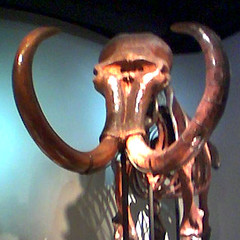In 1914, Othenio Abel, an Austrian paleontologist, suggested that the Cyclopes of Homeric legend was based on fossil elephant finds in antiquity. Abel, who excavated many Mediterranean fossil beds, related the image of one-eyed giant cavemen to the remains of Pleistocene dwarf elephants, common in coastal caves of Italy and Greece. Shipwrecked sailors unfamiliar with elephants might easily mistake the skull’s large nasal cavity for a central eye socket.(...)
In profile, the elephant skulls do resemble grotesque human faces, and the vertebrae and limb bones could be laid out to resemble a giant man. Anyone who saw such an assemblage would try to visualize how such a creature looked and behaved when alive. Since Cyclopes lived in caves, the ancient Greeks imagined them as primitive troglodytes who used rocks and clubs as weapons. The great piles of bones on the cave floors might be the remains of ship-wrecked sailors – the savage Cyclopes were probably cannibals!
The First Fossil Hunters: Paleontology in Greek and Roman Times Adrienne Mayor.







No comments:
Post a Comment